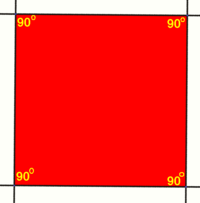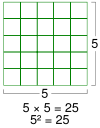Square (geometry)
2008/9 Schools Wikipedia Selection. Related subjects: Mathematics
| Square | |
|---|---|
 A square The sides of a square and its diagonals meet at right angles. |
|
| Edges and vertices | 4 |
| Schläfli symbols | {4} {}x{} |
| Coxeter–Dynkin diagrams | |
| Symmetry group | Dihedral (D4) |
| Area (with t=edge length) |
t2 |
| Internal angle (degrees) |
90° |
In plane (Euclidean) geometry, a square is a regular polygon with four sides.
Classification
A square (regular quadrilateral) is a special case of a rectangle as it has four right angles and parallel sides. Likewise it is also a special case of a rhombus, kite, parallelogram, and trapezoid.
Mensuration formulae
The perimeter of a square whose sides have length t is
- P = 4t.
And the area is
- A = t2.
In classical times, the second power was described in terms of the area of a square, as in the above formula. This led to the use of the term square to mean raising to the second power.
Standard coordinates
The coordinates for the vertices of a square centered at the origin and with side length 2 are (±1, ±1), while the interior of the same consists of all points (x0, x1) with −1 < xi < 1.
Properties
Each angle in a square is equal to 90 degrees, or a right angle.
The diagonals of a square are equal. Conversely, if the diagonals of a rhombus are equal, then that rhombus must be a square. The diagonals of a square are  (about 1.41) times the length of a side of the square. This value, known as Pythagoras’ constant, was the first number proven to be irrational.
(about 1.41) times the length of a side of the square. This value, known as Pythagoras’ constant, was the first number proven to be irrational.
If a figure is both a rectangle (right angles) and a rhombus (equal edge lengths) then it is a square.
Other facts
- If a circle is circumscribed around a square, the area of the circle is π / 2 (about 1.57) times the area of the square.
- If a circle is inscribed in the square, the area of the circle is π / 4 (about 0.79) times the area of the square.
- A square has a larger area than any other quadrilateral with the same perimeter ( ).
- A square tiling is one of three regular tilings of the plane (the others are the equilateral triangle and the regular hexagon).
- The square is in two families of polytopes in two dimensions: hypercube and the cross polytope. The Schläfli symbol for the square is {4}.
- The square is a highly symmetric object. There are four lines of reflectional symmetry and it has rotational symmetry through 90°, 180° and 270°. Its symmetry group is the dihedral group D4.
Non-Euclidean geometry
In non-euclidean geometry, squares are more generally polygons with 4 equal sides and equal angles.
In spherical geometry, a square is a polygon whose edges are great circle arcs of equal distance, which meet at equal angles. Unlike the square of plane geometry, the angles of such a square are larger than a right angle.
In hyperbolic geometry, squares with right angles do not exist. Rather, squares in hyperbolic geometry have angles of less than right angles. Larger squares have smaller angles.
Examples:
 Six squares can tile the sphere with 3 squares around each vertex and 120 degree internal angles. This is called a spherical cube. The Schläfli symbol is {4,3}. |
 Squares can tile the Euclidean plane with 4 around each vertex, with each square having an internal angle of 90 degrees. The Schläfli symbol is {4,4}. |
 Squares can tile the hyperbolic plane with 5 around each vertex, with each square having 72 degree internal angles. The Schläfli symbol is {4,5}. |
